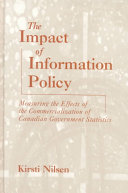

Most ebook files are in PDF format, so you can easily read them using various software such as Foxit Reader or directly on the Google Chrome browser.
Some ebook files are released by publishers in other formats such as .awz, .mobi, .epub, .fb2, etc. You may need to install specific software to read these formats on mobile/PC, such as Calibre.
Please read the tutorial at this link: https://ebookbell.com/faq
We offer FREE conversion to the popular formats you request; however, this may take some time. Therefore, right after payment, please email us, and we will try to provide the service as quickly as possible.
For some exceptional file formats or broken links (if any), please refrain from opening any disputes. Instead, email us first, and we will try to assist within a maximum of 6 hours.
EbookBell Team

4.8
94 reviewsThis book focuses on the effects of information policy. While information policy studies often consider the ideology underlying policy, the policy process, the stakeholders and players in that process, and the nature of the outcomes of policy development, there have been few studies that focus on the ultimate effects of information policy. This book looks at effects from two perspectives. First, it examines the impact of government-wide information policies on a specific government agency in terms of its dissemination policies for the information it provides. Secondly, the effects of the ensuing agency information policies on social science research are examined.
The government-wide policies of interest here are cost-recovery and restraint initiatives imposed by the Canadian federal government in the mid-1980s. The policy statements specifically identified government information as an area in which increased revenues could be generated. Such de facto information policies can have a wide effect on government information production and dissemination. In this book, the history and background of the policies is considered and the effects were empirically examined using multiple methods of analysis. The period covered is mid-1980s through mid-1990s. An epilogue chapter provides information on recent policy developments in Canada and the continuing effects of the policies of the 1980s.